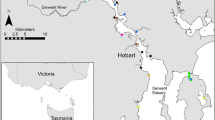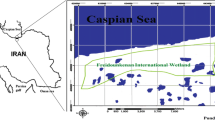Abstract
The variations of some metals including nickel, iron, copper, zink, mercury, lead, and cadmium were examined in wing primaries of dominant wintering waterfowl in international wetlands near the Caspian Sea’s southern basin, including graylag goose (Anser anser), mallard (Anas platyrhynchos), pintail (Anas acuta) and common teal (Anas crecca). The core question of this study is the determination of primary feathers arrangement in molting, growth pattern effects and its performance on the bioaccumulation of contamination and determining the best growth feather location for biomonitoring purposes. The metals content, overall trend lines, and correlations among the 10 primary wing feathers were compared, and molting effects and feather regrowth were investigated. The metals were measured by AMA 254 Advanced Mercury Analyzer and inductively coupled plasma atomic emission spectroscopy. In all the species, almost all primaries have simultaneous regrowth, but their growth continues irregularly. There were significant differences in metal differences with juvenile waterfowl that did not experience molting compared to adults that do. The results showed that all of the species (except common teal) have experienced molting due to the difference of Hg concentration between adults and juveniles. It seems unplanned or random selection of bird’s feathers to achieve pollutants monitoring purposes by previous studies’ methods can now be challenged. In order to examine the linear changes of some elements (mercury, copper, and zink), it is recommended to collect samples of middle primaries, while samples of the feather growth locations to study the linear changes of nickel, iron, lead, and cadmium are necessary.


Similar content being viewed by others
References
Abbasi NA, Jaspers VLB, Chaudhry MJI, Ali S, Malik RN (2015) Influence of taxa, trophic level, and location on bioaccumulation of toxic metals in bird’s feathers: a preliminary biomonitoring study using multiple bird species from Pakistan. Chemosphere 120:527–537
Abdullah M, Fasola M, Muhammad A, Malik SA, Bostan N, Bokhari H, Kamran MA, Shafqat MN, Alamdar A, Khan M, Ali N, Eqani SAMAS (2015) Avian feathers as a non-destructive bio-monitoring tool of trace metals signatures: a case study from severely contaminated areas. Chemosphere 119:553–561
Ahmadpour M, Hoseini SH, Ahmadpour M, Mashrofeh A, Sinkakarimi MH, Ghasempouri SM, Pourkhabbaz AR, Eskandari T (2013) Assessment of mercury concentration in feathers of six species of waterbirds in Southern Caspian Sea Wetlands. www.wesca.net, 8
Burger J (2013) Temporal trends (1989–2011) in levels of mercury and other heavy metals in feathers of fledgling great egrets nesting in Barnegat Bay, NJ. Environ Res 122:11–17
Burger J, Gochfeld M (1991) Lead, mercury, and cadmium in feathers of tropical terns in Puerto Rico and Australia. Arch Environ Contam Toxicol 21:311–315
Burger J, Seyboldt S, Morganstein N, Clark K (1993) Heavy metals and selenium in feathers of three shorebird species from Delaware Bay. Environ Monit Assess 28:189–198
Daryaei N, Mirdamadi M, Hosseini JF, Rahimi Soureh S, Arjomandi R (2014) Development of Economic, social and environmental sustainability indicators of fereydoonkenar international Wetland Site (Ramsar Site) by using Delphi Method. MAGNT Res Rep 2:504–524
Dauwe T, Lieven B, Ellen J, Rianne P, Ronny B, Marcel E (2002) Great and blue tit feathers as biomonitors for heavy metal pollution. Ecol Indic 1:227–234
Dauwe T, Bervoets L, Pinxten R, Blust R, Eens M (2003) Variation of heavy metals within and among feathers of birds of prey: effects of molt and external contamination. Environ Pollut 124:429–436
Furness RW, Monaghan P (1987) Seabird feeding ecology. Seabird ecology. Springer, Boston
Hahn E, Hahn K, Stoeppler M (1993) Bird feathers as bioindicators in areas of the German Environmental Specimen Bank–bioaccumulation of mercury in food chains and exogenous deposition of atmospheric pollution with lead and cadmium. Sci Total Environ 139–140:259–270
Mansouri B, Majnoni F (2014) Comparison of the metal concentrations in organs of two bird species from Western of Iran. Bull Environ Contam Toxicol 92:433–439
Mansouri B, Pourkhabbaz A, Babaei H, Hoshyari E (2012) Heavy metal contamination in feathers of Western Reef Heron (Egrettagularis) and Siberian gull (Larusheuglini) from Hara biosphere reserve of Southern Iran. Environ Monit Assess 184:6139–6145
Martínez A, Crespo D, Fernández JÁ, Aboal JR, Carballeira A (2012) Selection of flight feathers from Buteobuteo and Accipiter gentilis for use in biomonitoring heavy metal contamination. Sci Total Environ 425:254–261
Morel FM, Kraepiel AM, Amyot M (1998) The chemical cycle and bioaccumulation of mercury. Ann Rev Ecol Syst 29:543–566
Nighat S, Iqbal S, Nadeem MS, Mahmood T, Shah SI (2013) Estimation of heavy metal residues from the feathers of Falconidae, Accipitridae, and Strigidae in Punjab, Pakistan. Turk J Zool 37:488–500
Norouzi M, Mansouri B, Hamidian AH, Ebrahimi T, Kardoni F (2012) Comparison of the metal concentrations in the feathers of three bird species from Southern Iran. Bull Environ Contam Toxicol 89:1082–1086
Ochoa-Acuña H, Sepúlveda MS, Gross TS (2002) Mercury in feathers from Chilean birds: influence of location, feeding strategy, and taxonomic affiliation. Mar Pollut Bull 44:340–345
Pon JPS, Beltrame O, Marcovecchio J, Favero M, Gandini P (2012) Assessment of trace metal concentrations in feathers of White-chinned Petrels, Procellariaaequinoctialis, from the Patagonian shelf. Environ Pollut 1:29
Rajaei F, Esmaili Sari A, Bahramifar N, Ghasempouri SM (2010) Mercury concentration in 3 species of gulls, larusridibundus, larusminutus, laruscanus, from south coast of the Caspian Sea, Iran. Bull Environ Contam Toxicol 84:716–719
Rothschild RFN, Duffy LK (2005) Mercury concentrations in muscle, brain and bone of Western Alaskan waterfowl. Sci Total Environ 349:277–283
Seco Pon JPS, Beltrame O, Marcovecchio J, Favero M, Gandini P (2011) Trace metals (Cd, Cr, Cu, Fe, Ni, Pb, and Zn) in feathers of Black-browed Albatross Thalassarchemelanophrys attending the Patagonian Shelf. Mar Environ Res 72:40–45
Thompson DR, Bearhop S, Speakman JR, Furness RW (1998) Feathers as a means of monitoring mercury in seabirds: insights from stable isotope analysis. Environ Pollut 101:193–200
Ullah K, Hashmi MZ, Malik RN (2014) Heavy-metal levels in feathers of cattle egret and their surrounding environment: a case of the Punjab Province, Pakistan. Arch Environ ContamToxicol 66:139–153
Warner SE, Shriver WG, Olsen BJ, Greenberg RG, Taylor RJ (2012) Mercury in wing and tail feathers of hatch-year and adult tidal marsh sparrows. Arch Environ Contamin Toxicol 63:586–593
Zamani-Ahmadmahmoodi R, Esmaili-Sari A, Ghasempouri SM, Savabieasfahani M (2009a) Mercury in wetland birds of Iran and Iraq: contrasting resident Moorhen, Gallinulachloropus, and migratory common teal, Anascrecca, life strategies. Bull Environ Contam Toxicol 82:450–453
Zamani-Ahmadmahmoodi R, Esmaili-Sari A, Ghasempouri SM, Savabieasfahani M (2009b) Mercury levels in selected tissues of three kingfisher species; Cerylerudis, Alcedoatthis, and Halcyon smyrnensi, from Shadegan Marshes of Iran. Ecotoxicology 18:319
Zamani-Ahmadmahmoodi R, Esmaili-Sari A, Savabieasfahani M, Bahramifar N (2010) Cattle egret (Bubulcus ibis) and little egret (Egrettagarzetta) as monitors of mercury contamination in Shadegan Wetlands of south-western Iran. Environ Monit Assess 166:371–377
Zolfaghari G, Esmaili-Sari A, Ghasempouri SM, Kiabi BH (2007) Examination of mercury concentration in the feathers of 18 species of birds in southwest Iran. Environ Res 104:258–265
Acknowledgements
We would like to thank Zahedan University for their assistance with metal measurements. We would also like to thank Dr. Reza Dahmardeh, the lecturer of Zabol University, and Manzar Haghdoost, the laboratory expert of Tarbiat Modares University for their assistance and cooperation. This study was supported by the fund of the Tarbiat Modares University (Tehran, Iran) (Grant No. 152D/3351). All of the experiments have been covered by the financial support of the Tarbiat Modares University.
Author information
Authors and Affiliations
Corresponding author
Additional information
Editorial responsibility: T. Karak.
Electronic supplementary material
Below is the link to the electronic supplementary material.
Rights and permissions
About this article
Cite this article
Sadeghi, M., Ghasempouri, S.M. & Bahramifar, N. Xenobiotic and essential metals biomonitoring by feathers: molting pattern and feather regrowth sequence in four dominant waterfowl. Int. J. Environ. Sci. Technol. 16, 125–134 (2019). https://doi.org/10.1007/s13762-017-1557-y
Received:
Revised:
Accepted:
Published:
Issue Date:
DOI: https://doi.org/10.1007/s13762-017-1557-y




